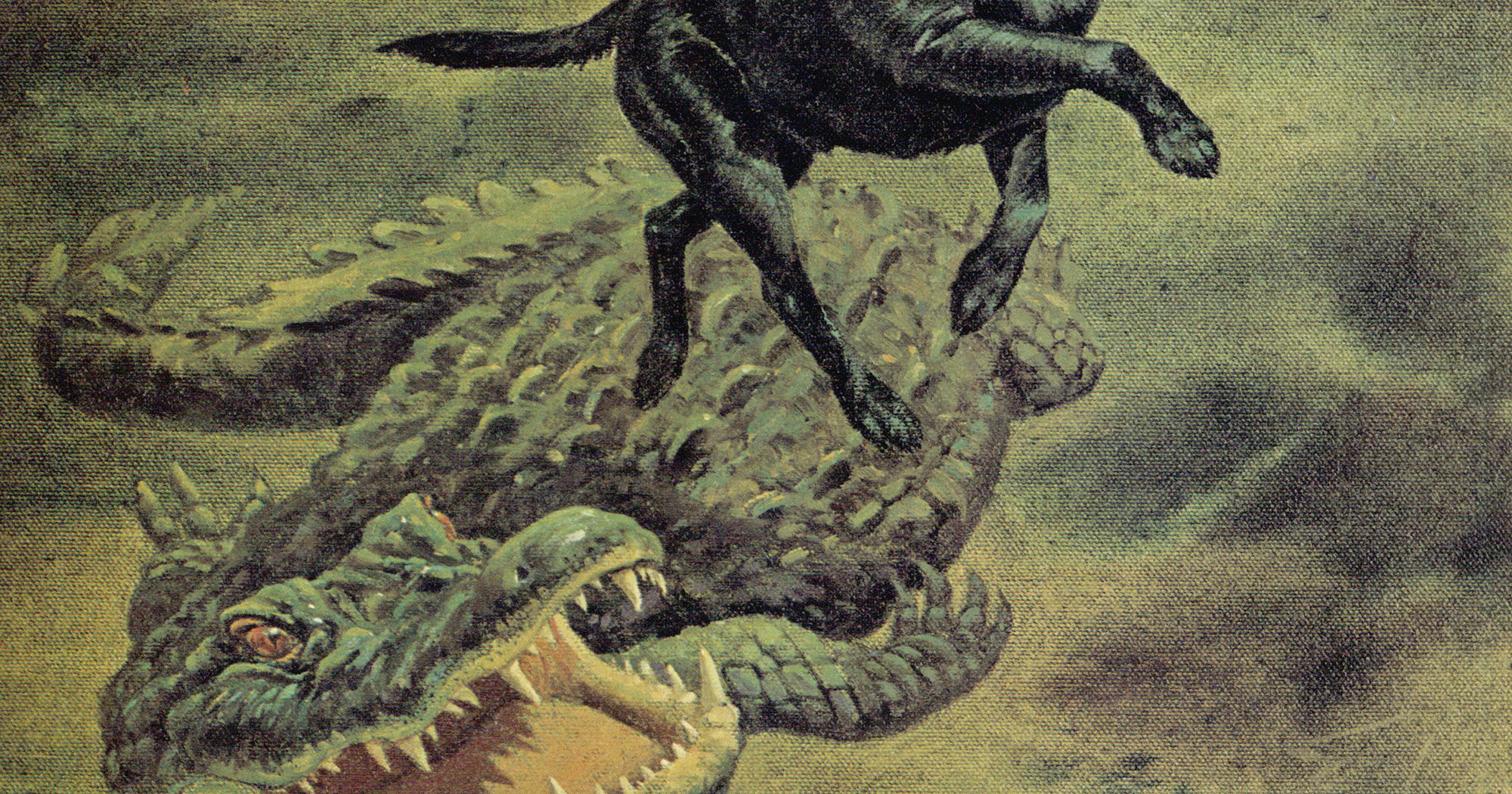This story, “Jaws That Are Real,” appeared in the February 1982 issue of Outdoor Life. The American alligator was delisted from its “threatened” status under the Endangered Species Act in 1987.
It was nearly dark. Sixteen-year-old Sharon Holmes dug her toes into the smooth sand of the lake bottom and let the warm water buoy her up. She listened to the frogs peeping in the calm Florida evening. Her father relaxed on shore not far away, enjoying the peace of the cypress-ringed lake.
Across the lake, a creature left over from the age of dinosaurs was also enjoying the evening. But he was hungry. With a sinuous wave of his six-foot tail, he slipped into the water and began to glide along the shore in his nightly hunting pattern, moving slowly, only his eyes and the tip of his nose above water betraying his presence.
Perhaps the girl’s head, the only part of her above the surface, seemed to be a small animal swimming across the lake. The 11-foot giant slipped under water and glided toward her, coming up occasionally to recheck her position.
When he was about 40 feet away, the 600-pound monster went down for the final stalk. He slid up to the girl without making a ripple. When his jaws were beside her, he threw open his yard-wide mouth, slammed his head sideways and crushed his spiked teeth into her arm.
Sharon’s panicked screams brought her father out of his reverie instantly. He could see her fighting frantically as the water foamed around her. He rushed to help her. Grabbing her free arm he began to pull with all his strength. Something was holding her down, but he couldn’t see what. Gradually, inexorably, the mindless force pulling Sharon toward deeper water overpowered him. As he watched in agony, his daughter was torn from his grasp. She disappeared into the boiling black water.
Three hours later, rescue teams from nearby Sarasota found Sharon Holmes’ remains. Both arms had been severed. Sharon Holmes was killed 10 years ago, and she was the first human killed by an alligator in the United States in many years, but she would not be the last.
Florida and several other Southeastern states are in the middle of an alligator explosion. After hunting was outlawed, the gator population bloomed to over a million of the big saurians in Florida alone. At the same time, more and more human residents were moving into the “gator belt” to avoid cold weather and high fuel bills farther north. Conflicts and disasters were bound to become increasingly frequent.
Two years after the Sharon Holmes attack, wildlife biologist Kent Keenlyne of Gainesville, Florida, was working turtle traps in a remote stretch of the Oklawaha River. The catch was good. Keenlyne, a husky 34-year-old, had pulled several snappers from the traps as he stood in waist-deep water next to his johnboat. It was a quiet fall afternoon, the kind that made Keenlyne glad to be on the river alone.
But as he reset a trap, the young biologist suddenly, desperately wished he had someone with him. Without warning, he felt his feet swept from under him by an enormously powerful force. He fell, going under the water, still unable to see his adversary.
Seconds later, before he could get his feet under him, he felt a pair of mighty jaws slamming down on his right shoulder and arm. The massive gator, nearly 12 feet long, shook him like a terrier with a rat, attempting to stun him. Keenlyne frantically fought back, realizing that he might have only minutes to live. He grabbed the gator’s nose with his free left hand and pushed with all his might, trying to open the jaws. He couldn’t budge the viselike grip, but as he and the big saurian struggled and pulled, he felt the tissue in his arm begin to give. Suddenly a shoulder tendon popped, and he felt the muscle on his shoulder and arm torn free of the bone. The ripped flesh slipped free of the great jaws and Keenlyne instantly leaped to his feet. Red water flowed around the combatants. He pounded the gator in the snout and eyes with his good hand, roaring in anger and pain. The giant reptile struck again, the inch-long teeth flashing ivory as the head slashed sideways. Keenlyne fended off the strike with his hands, man aging to keep them outside the jaws as the mouth slammed shut like a bear trap.
The gator then submerged, perhaps preparing to knock his prey down again with his tail. For the first time Keenlyne was able to lunge for his boat, which floated only five feet away. Splashing blood and water, he rolled over the gunwale to safety. The gator, apparently seeing his quarry escape, slipped away beneath the water.
Keenlyne survived to become a student of alligator behavior, but he carries an arm and shoulder full of scars to remind him of the encounter. Two others were not so lucky. In 1977 and again in 1978, giant gators killed Floridians. More than 40 humans have been attacked [in the 10 years] since 1972. Many were clearly victims of “feeding attacks,” where the gator’s intention was not to drive off intruders or to protect himself, but to fill his stomach.
Biologists such a Tommy Hines, who works for the Game and Fresh Water Fish Commission, believe Florida’s alligator problems and their attacks on humans may increase unless control measures are taken.
“Due to the strict protection afforded under the Endangered Species Act in the late 1960s, the gator population here has exploded,” says Hines. “We have alligators up to our ears — as many as seventy per mile of shoreline in some lakes such as Griffin, near Leesburg. In Orange Lake we may have close to six thousand gators in only nine thousands acres of water.”
In 1976 the Florida Game and Fresh Water Fish Commission received more than 10,000 calls about gators that were endangering people, pets or livestock. The state already spends a quarter of a million dollars annually handling problem gators.
As more and more people flood into Flor ida, conflicts with the still-expanding gator population are likely to increase. And the chronic low-water situation is moving gators out of the remote swamps where they usually live unseen and into lakes and rivers surrounded by new homes.
The alligator explosion is by no means limited to Florida. Louisiana and Texas are prime gator states because of extensive marshes and winter temperatures in their southern portions that rarely drop much below 35. Gators thrive in this habitat, growing as much as a foot a year. Females lay 35 to 40 eggs each spring, and though less than half of these survive the first year, the big reptiles still manage remarkable population increases when not molested by poachers.
In Louisiana’s Cameron Parish, poachers had all but eliminated the gator by 1963. But the Department of Wildlife and Fisheries imported a few gators from other parishes and began strict enforcement of poaching laws, and by 1969 there were so many gators in the parish that trappers com plained that all the nutria, muskrat and mink were being gobbled up. To make things worse, a good many duck hunters saw their prize Labrador retrievers disappear in a welter of foam as big gators ate everything that invaded their domain. Alligators showed up in swimming pools and on four-lane highways, and became a hazard to navigation in marshland canals. [As of press time] the state has more than 500,000 of these animals, and most available marsh is at maximum carrying capacity.
In Texas the alligator has also recovered remarkably. Biologist Floyd Potter Jr. reports that the population grew more than 50 percent in the four years from 1974 to 1978. Today [in 1982] there are more than 100,000 alligators in the limited marsh areas along the Texas coast, and most habitat appears to be at or over maximum carrying capacity. This crowding forces some gators out of the swamps and into suburban yards looking for food. There are more than 100 gators per square mile in some Texas marshes.
Alabama, Arkansas, Georgia, Mississippi and North and South Carolina all have increasing gator populations as well. In Georgia the population doubled in the past five years and now stands at 85,000. But in these states habitat is more limited, and the cooler temperatures cause the gators to go through a long dormancy period each winter. Consequently, their growth is much slower-as little as four inches a year. It takes much longer for an alligator to reach the six-foot length generally recognized as the size of sexual maturity, and also the length at which a gator may attack man.
Really big gators are uncommon in these states, and for that reason most game biologists see them as little real threat to man or large animals. According to South Carolina biologist John Cely, “most of the so-called ‘problem’ gators in our region are a problem only in the minds of residents who have little or no experience with the animals. They present very little danger to anybody if they’re not molested. To represent the alligator as some kind of bloodthirsty monster would be inaccurate in our state.”
Clearly there’s not an alligator under every lily pad waiting to gobble up the unsuspecting outdoorsman, not even in Florida. Most gators stay well away from people when given the opportunity. But I began to wonder when a feisty four-footer lunged at me beneath the picnic table at my suburban home a few years ago. His jaws snapped shut on my thick athletic sock instead of my leg, but the surprise of the attack had my hair standing on end for a few minutes. The creature obviously attacked because he felt cornered. I captured that gator and returned him to a nearby marsh.
But I wanted no part of a much bigger gator that approached me one morning when I was wade-fishing for bass on Lake Galona near Orlando. I saw the old boy, a 1O-footer, giving me the once-over from maybe 300 yards out as he floated high in the water, relaxing. The next time I spotted him he was less than 100 yards away, showing only his eyes and the tip of his nose pointed right at me. I had some suspicions about him at that point and began backpedaling out of the chest-deep water in which I had been fishing, pushing my way into a heavy stand of maiden cane. When the gator popped up seconds later, he was exactly where I had been standing at the edge of the cane, not 20 feet away. At that point I turned around and gave an excellent imitation of a paddlewheel steamer as I went churning for shore; water, grass and tackle flying every which way. The alligator didn’t attempt to rush me, but I’ve often wondered what would have happened if I’d still been there when he popped up.
Despite these incidents, alligators rarely attack or harass humans. Dogs are not so fortunate. Fine hunting dogs are taken by gators each year, as Chick Cowan can relate. Cowan had completed a successful morning shoot on Hall’s River near the village of Homosassa, Florida and was giving his young Labrador a bit of retrieving practice. He repeatedly threw a dead duck into the river, and the eager black pup charged after it time after time. Then, just as the dog turned back toward Cowan, it yipped, struggled and disappeared beneath the water. Cowan saw only the brief thrashing of a green and black tail that identified the attacker as a gator, probably about 10 feet long. Though he rushed into the river to try to help, both the dog and the alligator disappeared immediately.
Bloodthirsty or not, the alligator obviously is no longer an endangered or even threatened species throughout the southern part of its range, despite the federal laws that still proclaim it to be so. Instead, the animal is an abundant beast that scientists say has lived in close to its present form for nearly 140 million years. Gators grow to enormous size; the unofficial record taken in 1890 was more than 19 feet long. And they have remarkable predatory abilities. In a witnessed incident, a large gator killed a full-grown black bear that was attempting to swim a river. They often take hogs, deer and domestic calves in addition to their regular diet of trash fish, turtles and birds.
The American alligator is as much a symbol of wild country in the Southeastern swamps as the grizzly is in the Western mountains, but it’s much more numerous than the grizzly. It’s good to eat, has a marketable hide and makes a great mounted trophy. In short, the alligator has the potential to become an outstanding addition to the list of big-game animals huntable in the three states where it’s most abundant.
At present, only Louisiana is actively controlling its alligator population. It has done so since I972, through carefully monitored commercial harvest. And during that period, the alligator population has continued to increase dramatically.
It would appear from Louisiana’s experience that alligators, like whitetail deer, are readily managed by controlled hunting, and that they benefit from selective cropping.
Florida and Texas officials agree, and expect to begin harvesting gators in the near future. Florida held an experimental hunt on Orange Lake in September of 1981, aiming to establish a regular harvest within a year as approval is granted by the U.S. Fish and Wildlife Service. Texas expects to follow. But both these states plan to make the gator strictly a commercial animal, taken by gun and light or setlines by a few licensed commercial hunters. This is understandable in areas where the marshes are privately owned, and the landowner expects to collect a share of the very lucrative prices received for the gator hides-as much as $18 a foot now. But in each of these states there are considerable numbers of gators in public lakes and state-owned marshes. In Florida the vast majority of the big reptiles inhabit public waters. A lot of sportsmen, myself included, are starting to wonder why these animals should be bestowed on a few commercial hunters.
So-called “sport hunting” is now available in Louisiana. The sportsman purchases a $150 permit, then he accompanies a commercial trapper when the professional runs his setlines. The sportsman selects his gator from among those the trapper hauls in on his baited hooks, and shoots the gator of his choice. The commercial hunter-trapper gets a $400-a-night guide fee plus additional fees for the skin, the meat and for skinning out the sportsman’s kill.
Most of the game-department officials I spoke with felt that if a sport season were opened, controlling the harvest would be more difficult and that there would be a greater likelihood that females and immature gators would be taken as well as the adult males. (Commercial harvesting uses selective techniques that limit the kill primarily to adult bulls.)
But it seems that with the proper controls, these problems could be solved. It has been done with many other animals. Why not make the gator huntable on a permit basis, such as is done in the Western states with many big-game animals? Only hunters lucky enough to draw a permit would have a chance at taking a gator. Game departments could keep a precise handle on the total kill by the return of filled tags, and a permanent tag could be affixed to each skin offered for sale. Permit fees could pay for the added enforcement required to assure a minimum of illegal kills.
Some biologists I spoke with feel that hunting alligators isn’t really very sporting. The traditional hunt took place at night. Using a high-powered light, the hunter spotted his quarry by watching for the shin ing eyes and then put a bullet between them. The gator usually sank instantly, and had to be grubbed up with a long-handled gaff. Inevitably, some were lost.
Today gators are also taken commercially with baited hooks on setlines in Louisiana. The hooked gator is hauled up to the boat or bank and shot. But there are many other ways of taking gators that would require both skill and a little nerve, should game departments choose to allow sport hunting.
Florida biologist Tommy Hines suggests that one of the most exciting ways of taking a gator is to slip up in a small boat and harpoon it. “You stick a 12-footer this way, as I’ve done in our gator control program, and you’ll go through a battle you’ll never forget, I guarantee it,” says Hines. Other biologists suggest that powerful compound bows combined with some sort of heavy duty bowfishing reels might be sporty gear for taking gators without much danger of losing them. The close stalk necessary to properly place an arrow would make for an exciting and challenging hunt. And by limiting hunting areas to open lakes and canals where bull gators roam, the kill of females could be limited. Females and smaller males usually remain in marshlands and avoid open water.
Read Next: Grizzly Bears Will Remain on Endangered Species List, Feds Say
Sport hunting seems likely to have the same beneficial effect on the alligator population that it has on the whitetail deer herds in the Southeast. Overcrowding, stunting and disease could be controlled, assuring the future of this remarkable creature in an area where available habitat is shrinking each year. In addition, the American sports man would have a new quarry. And as the gator becomes aware of man as a potential predator rather than helpless prey, incidents like the one that took Sharon Holmes’ life would grow rare and perhaps end completely.
Read the full article here




